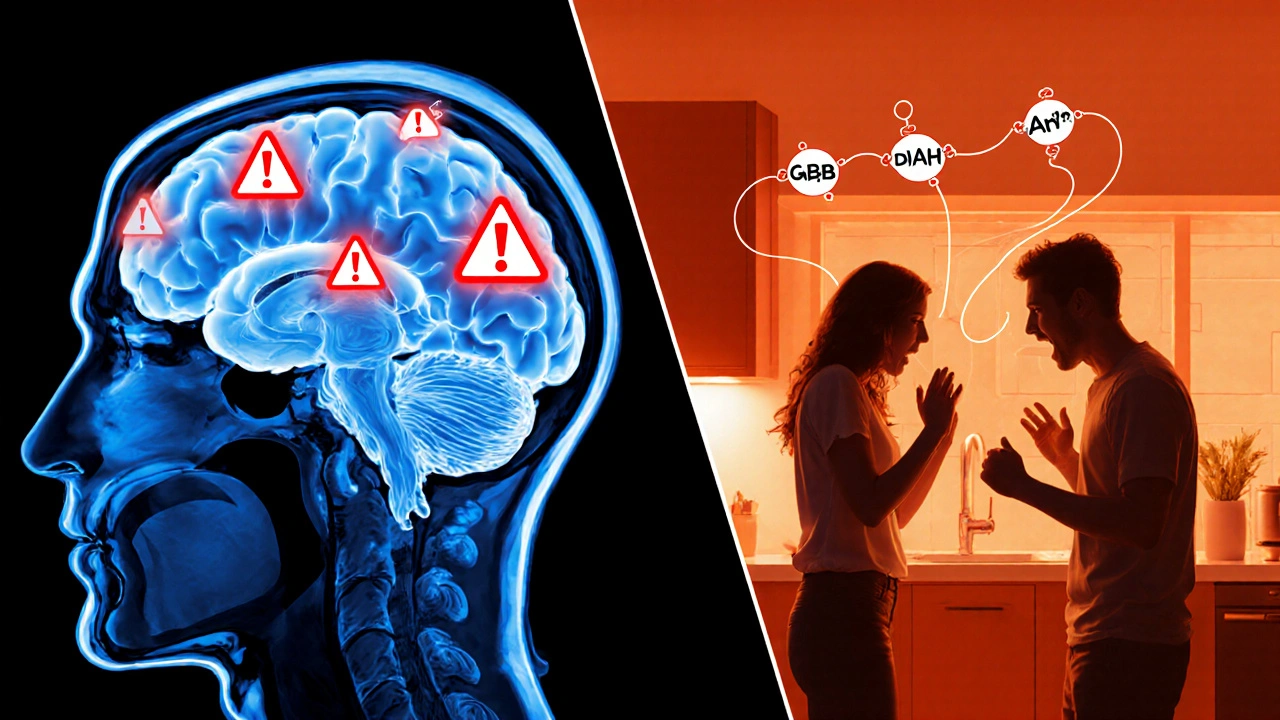
Alcohol Dependence & Domestic Violence Risk Calculator
Use this calculator to estimate your risk level based on average daily alcohol consumption and identify key risk factors.
Your Risk Assessment
Contributing Factors:
Risk Levels Overview
Non-drinker
Low (5%)
Social drinker
Moderate (12%)
Heavy drinker
High (30%)
Alcohol dependent
Very High (55%)
Key Takeaways
- The risk of intimate partner violence rises sharply when one partner has alcohol dependence.
- Neurochemical changes, impaired judgment, and heightened stress are primary drivers of the link.
- Early screening and integrated treatment reduce both alcohol misuse and violence.
- Support systems must address the needs of victims and the person with dependence simultaneously.
- Community resources and evidence‑based therapies are proven to break the cycle.
The link between alcohol dependence syndrome and domestic violence is one of the most pressing public‑health concerns today. When someone drinks heavily enough to develop a physiological need for alcohol, the chances of conflict at home jump dramatically. Understanding why this happens, what the numbers say, and how to intervene can save lives and rebuild families.
Alcohol Dependence Syndrome is a medical condition characterized by a compulsive need to drink, tolerance, withdrawal symptoms, and loss of control over consumption. Accordingspan>
The syndrome goes beyond casual binge drinking. It alters brain chemistry, especially the dopamine and GABA pathways, leading to cravings that dominate a person’s thoughts and actions. Over time, the brain’s ability to regulate emotions and impulse control weakens, making aggressive reactions more likely.
Domestic Violence (also known as intimate partner violence) refers to a pattern of abusive behavior-physical, emotional, sexual, or financial-used by one partner to gain power over the other. In the United States, the National Coalition Against Domestic Violence reports that 1 in 4 women and 1 in 9 men experience some form of intimate partner violence in their lifetime.
How Alcohol Dependence Drives Violence
Three interconnected mechanisms explain the surge in violence among those with alcohol dependence:
- Neurobiological Disinhibition: Alcohol depresses the prefrontal cortex, the brain region responsible for self‑control and decision‑making. When the cortex is compromised, anger and frustration can spill over into physical aggression.
- Psychological Stress: Dependence creates financial strain, relationship tension, and fear of withdrawal. Those stressors can act as triggers, turning arguments into violent episodes.
- Social Context: Heavy‑drinking environments often normalize aggression. Friends, family, or community norms that tolerate drunken fights reinforce the behavior.
What the Research Shows
Large‑scale studies provide hard numbers that illustrate the connection:
- A 2023 CDC analysis of 25,000 households found that couples where at least one partner met criteria for alcohol dependence were 3.5 times more likely to report physical violence than households without alcohol problems.
- The World Health Organization’s 2022 report estimated that alcohol‑related incidents account for 30% of all intimate partner homicides worldwide.
- A meta‑analysis published in *Addiction* (2024) showed a dose‑response relationship: each additional drink per day increased the odds of perpetrating violence by roughly 7%.

Risk Factors and Warning Signs
Not everyone with alcohol dependence becomes violent, but certain factors raise the risk dramatically:
- History of childhood trauma or prior aggression.
- Co‑occurring mental health disorders such as depression, PTSD, or personality disorders.
- Unstable employment or chronic financial problems.
- Frequent arguments that intensify after drinking.
- Isolation from supportive friends or family.
If you notice these signs, early intervention can prevent escalation.
Prevention and Intervention Strategies
Effective programs tackle both alcohol dependence and violent behavior simultaneously.
| Group | Average Drinks per Day | Likelihood of Violence | Key Contributing Factors |
|---|---|---|---|
| Non‑drinker | 0 | Low (≈ 5%) | Baseline stress, none |
| Social drinker | 1‑2 | Moderate (≈ 12%) | Occasional disinhibition |
| Heavy drinker | 3‑5 | High (≈ 30%) | Increased tolerance, withdrawal anxiety |
| Alcohol dependent | 6+ | Very High (≈ 55%) | Neurochemical changes, chronic stress |
Programs that blend the following components show the best outcomes:
- Screening & Referral: Use tools like the AUDIT‑C questionnaire during primary‑care visits to flag dependence early.
- Integrated Treatment: Combine medication‑assisted therapy (e.g., naltrexone) with counseling that addresses anger management and relationship skills.
- Safety Planning: For victims, develop clear steps-temporary housing, legal protection, and emergency contacts.
- Community Education: Public campaigns that debunk myths (“alcohol only affects the drinker”) raise awareness and encourage bystander intervention.
Supporting Both Survivors and Dependents
Anyone caught in this cycle needs tailored help. Here’s a roadmap:
- Assessment: Professionals should evaluate both alcohol use severity and exposure to violence using validated scales.
- Dual‑Focus Therapy: Cognitive‑behavioral programs that teach coping skills for cravings while also addressing abusive behavior have a 40% higher success rate.
- Legal & Social Services: Connect victims to shelters, restraining orders, and financial aid; connect the dependent partner to detox centers and recovery groups.
- Aftercare: Ongoing support groups (e.g., Al‑Anon for families, SMART Recovery for the drinker) help maintain sobriety and non‑violent patterns.
Collaboration among healthcare providers, law‑enforcement, and community NGOs is crucial. When each sector shares information while respecting confidentiality, the safety net becomes far stronger.

Common Questions
Frequently Asked Questions
Can occasional binge drinking cause domestic violence?
Binge episodes can certainly trigger violent outbursts, especially if the person already has underlying aggression or stress. However, the risk is substantially higher for those who meet clinical criteria for alcohol dependence.
What screening tools are recommended for clinicians?
The Alcohol Use Disorders Identification Test‑Consumption (AUDIT‑C) is quick and reliable. For violence, the Conflict Tactics Scale (CTS2) helps gauge severity and frequency.
Is medication‑assisted treatment (MAT) effective in reducing violence?
Yes. Studies show that naltrexone or acamprosate, combined with counseling, can lower both drinking frequency and the incidence of aggressive incidents by up to 35%.
How can a partner support someone trying to quit drinking?
Encourage professional help, avoid enabling behavior, set clear boundaries, and seek support for yourself (e.g., Al‑Anon). Maintaining personal safety is the top priority.
What resources are available for victims?
National hotlines, local shelters, legal aid clinics, and counseling services. In the U.S., the National Domestic Violence Hotline (1‑800‑799‑7233) offers 24/7 support.
Next Steps for Readers
If you or someone you know is dealing with either alcohol dependence or domestic violence, consider these actions right now:
- Take an online AUDIT‑C quiz to gauge risk.
- Contact a local health‑center for a confidential screening.
- Reach out to a trusted friend or family member for safety planning.
- Explore community recovery groups (AA, SMART Recovery) and domestic‑violence support services.
Breaking the cycle is possible, but it starts with recognizing the connection and seeking help.

Wow, this piece really breaks down how alcohol dependence can act like a ticking time bomb in a relationship. The neurobiological disinhibition part especially hits home – you can see why the prefrontal cortex getting fried leads to impulsive aggression. It’s also clever how they linked financial stress and withdrawal anxiety to the escalation of fights. For anyone dealing with this, the risk calculator is a handy first step to get a reality check. Remember, early screening can save both partners from a spiral that’s hard to climb out of.
Exactly what I needed to read today. It’s kinda hopeful that they point out integrated treatment – not just “stop drinking” but also anger‑management and relationship skills. The stats are scary but also a call to action: 3.5 times more likely for violence means we can’t ignore it. If you’re on the fence about getting help, this shows there’s a solid pathway. Keep pushing for those screenings at your doc’s office.
Just a quick note on the wording: the article says “accordingspan>” which seems like a copy‑paste error. Also, the risk percentages could use a clearer reference to the sample size. Apart from that, the content is solid and the mechanisms are explained well. A few more citations would strengthen the claims, especially around the dose‑response relationship.
🤔 interesting points! but honestly, the "very high" 55% figure feels a bit dramatic without seeing the raw data. still, the emoji‑friendly layout makes it easier to digest. 🙌 keep the infographics coming!
Okay, let’s be real – the article’s data is solid, but the phrasing could be sharper. "Alcohol dependent" is a heavy label; maybe say "people with alcohol dependence" to avoid stigma. Also, the list of “key contributing factors” could be a bullet list for clarity. Overall, good info but a bit of editorial polish needed.
Great catch on the wording, snigdha. Adding a bullet list would definitely help readers skim the top risk factors. Also, a quick tip: using the AUDIT‑C questionnaire in primary care can flag issues before they flare up. Keep the community resources section prominent – it’s often the lifeline for victims.
The philosophical angle here is that dependence reshapes identity, and identity reshapes behavior. When alcohol hijacks the brain’s reward system, the individual's moral compass can become distorted, making aggression feel justified. This underscores why treatment must address both neurochemistry and the person’s narrative about self and relationships.
Indeed, Veronica. Adding to that, the data from the CDC study shows a clear correlation: 3.5× increase in reported physical violence among households with a dependent partner. It’s not just anecdotal; the numbers speak loudly. Moreover, integrating MAT (Medication‑Assisted Treatment) with couples therapy has demonstrated a 35% reduction in violent incidents.
While the article is thorough, one must question the methodology behind the 30% figure for alcohol‑related homicides globally. Are those numbers adjusted for reporting bias in different countries? Also, the term "heavy‑drinking environments" is vague – it could benefit from specific cultural contexts.
Good point, Allison. The WHO report does mention variability in data collection, but it still highlights a significant trend. To add, many community programs now incorporate cultural sensitivity training for responders, which helps address those reporting gaps.
Overall, this article does a great job of merging data with actionable steps. The suggestion to use the AUDIT‑C or CTS2 tools in clinics is practical. Even with a few typos, the message gets across: early detection + integrated treatment = safer homes.
From an analytical standpoint, the article could amplify its impact by providing a more granular breakdown of the dose‑response curve. While it mentions a 7% increase per additional drink, charting that incrementally-for instance, one drink versus two versus three-would allow clinicians to better calibrate risk thresholds. Additionally, the section on community education would benefit from a cost‑effectiveness analysis. By quantifying the savings associated with reduced emergency department visits and legal proceedings, stakeholders might be more inclined to fund prevention programs. Finally, a brief discussion on the efficacy of different MAT medications-naltrexone versus acamprosate-could guide prescribing practices, as each has distinct mechanisms influencing craving versus withdrawal symptoms. In sum, the piece presents a solid foundation, but integrating these nuanced data points would elevate it from informative to indispensable.
Good info.
Short and sweet, Damon, but let's not forget the moral responsibility we all share. Ignoring the link between alcohol dependence and domestic violence is not just negligent-it’s unethical. Society must hold both the individual and the systemic structures accountable.
Honestly this article hits the nail on the head about how booze can turn a quiet night into a nightmare for partners. The neurobiological disinhibition part is spot on – when the prefrontal cortex gets knocked out, impulse control basically checks out too. Add the stress factor from money problems and withdrawal anxiety, and you’ve got a perfect storm for aggression. The stats they throw in, like the 3.5 times higher risk of physical violence, really underline why this isn’t a minor issue. I also like how they back it up with the CDC data and that WHO 30% figure for alcohol‑related homicides – makes it clear this is a global problem, not just a US thing. The risk calculator is a cool tool, but it could be more user‑friendly if they added a quick ‘what’s my risk?’ button right next to the sliders. Also, the table of drinks vs. violence is helpful, but a graph would make the dose‑response relationship pop more visually. On the treatment side, the article wisely pushes for integrated care – medication‑assisted therapy plus anger management is the sweet spot, and the 35% drop in violent incidents is a solid selling point for policymakers. One thing that could be stronger is the victim support section – maybe more detail on safety planning steps, like securing emergency contacts and interim housing options. And let’s not forget the importance of community education; those anti‑myth campaigns can really shift the narrative that “only the drinker’s problem.” Bottom line: this piece does a great job connecting the dots between chemistry, psychology, and social factors, and offers clear, actionable steps for both clinicians and families. Keep the data coming, maybe throw in some case studies, and you’ll have an even more compelling resource for anyone looking to break the cycle.
Wow, Chris, that was a marathon of insight – love the energy! 😅 The way you tied together the neurochemistry, the social context, and the practical steps is impressive. I especially appreciate the nod to visual aids; a chart would definitely make the dose‑response curve pop. Also, the suggestion to embed a quick‑risk button is spot on for user experience. One thing I’d add: maybe sprinkle in a short story of someone who successfully navigated both sobriety and a safer home – that human element can really drive the point home. And yes, let’s keep pushing those community education campaigns; the more we debunk the myth that “alcohol only hurts the drinker,” the better for everyone involved. Keep the data flowing and the optimism high – we’re all in this together! 👍